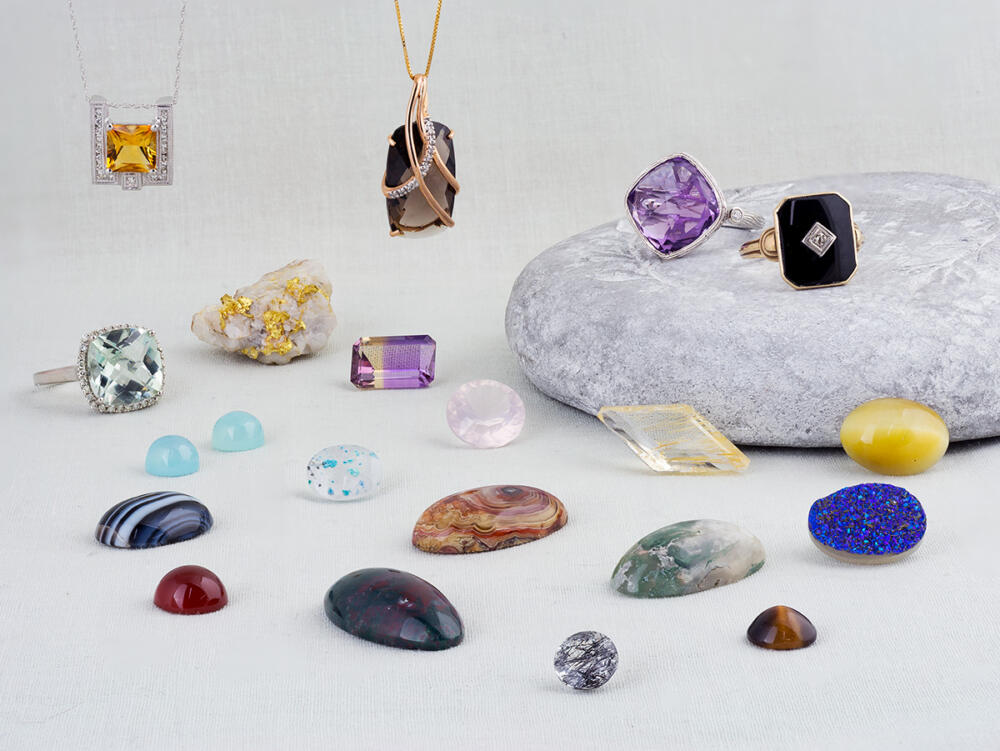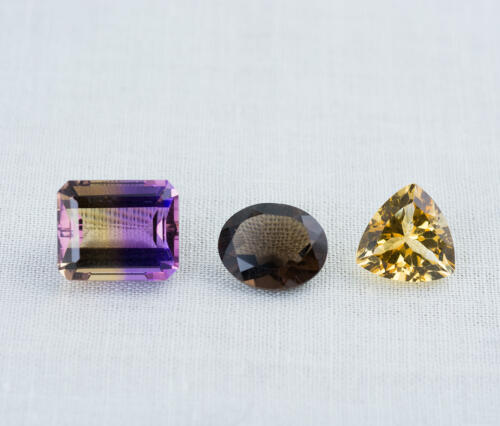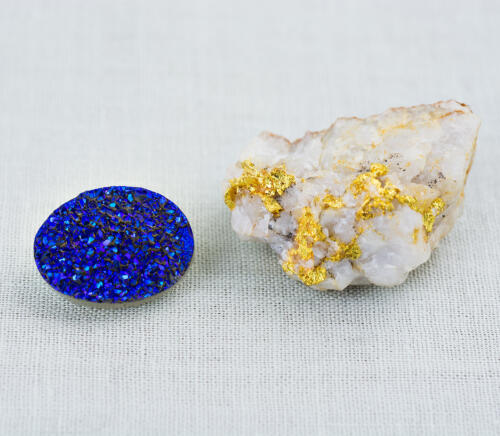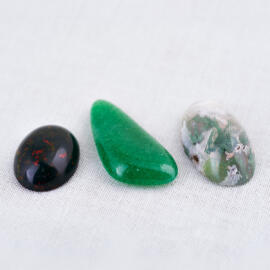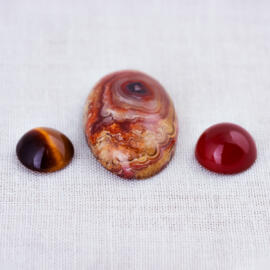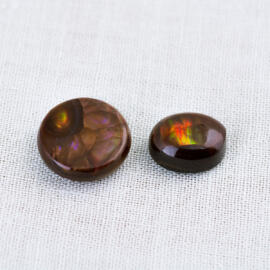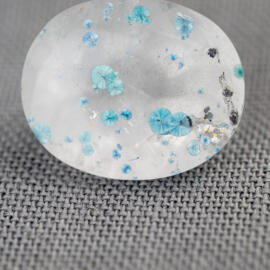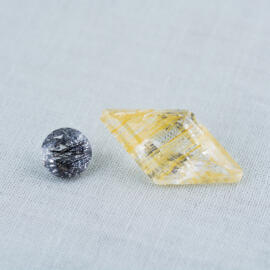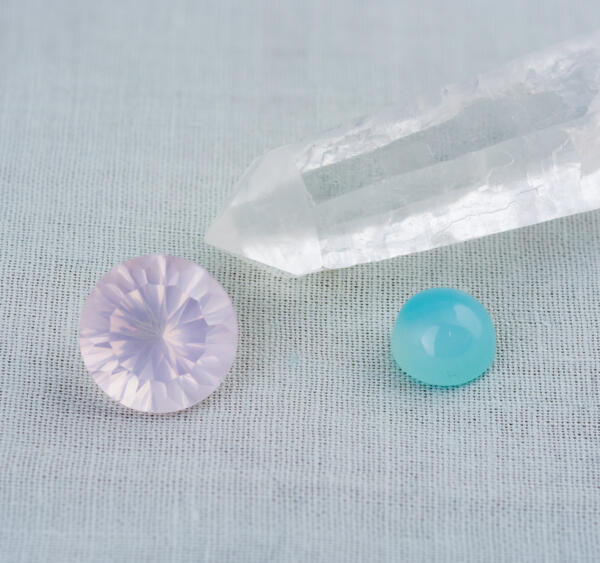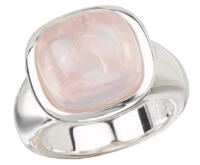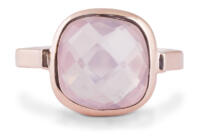Gem in the Spotlight: Quartz
The everyday and the extraordinary in one
What is common and yet rare? What is well known but surprising? What is affordably priced sometimes and sometimes unattainably expensive? If you answered quartz to all these questions you would be right (but naturally you looked at the title and knew).
Quartz is one of the most common minerals on earth. Many quartz varieties are cut into gemstones, but some varieties are very rare. Some are ordinary like rock quartz, others are exotic like Drusy Quartz. Some quartz material is a dollar per pound while others are $1,000+ per carat. Quartz is a gemstone with surprising variety.
The most important reason for this variety is that quartz comes in 3 main forms: macrocrystalline, microcrystalline and cryptocrystalline. Within each of these broad categories, the different colors of the gemstone are given different names. Below is a quick list to help you get a better handle on the vast diversity of quartz.
Before we dive in to the list, we need to touch on the most dangerous part of the quartz story: the naming of names. No matter how long we make this list, there’s sure to be some varieties missing. Then, there’s the whole thorny issue of misnomers–misleading names for gems. Quartz seems to have more than its fair share of misnomers. One famous one is “Alaska Diamond” for rock crystal alongside “Herkimer Diamonds” (see below). In recent times, the term “Green Amethyst,” which was commonly used for Prasiolite, has come under fire. It even attracted the attention of the US Federal Trade Commission which effectively banned its use when describing green quartz.
The Macrocrystalline or Crystal Varieties of Quartz
These gems are made of one, single crystal, and they include some of the most widely known and recognizable quartz species.
If you were born in February, you probably already know all about Amethyst since it’s your birthstone. Of course, the same also goes for November babies and Citrine. You may be less familiar with some of the other single crystal varieties of quartz like Rose Quartz, Morion, and Rutilated Quartz. These less common gems can be stunningly beautiful and intricate.
You can also see why Prasiolite has previously been referred to as “Green Amethyst.” Under the surface, all of these fancy names are just different ways of saying “Quartz!”
| Crystal Name | Color |
|---|---|
| Amethyst | Purple |
| Citrine | Yellow to reddish orange to brown, greenish yellow |
| Prasiolite | Green (often mistakenly referred to as Green Amethyst) |
| Rock Quartz | Clear |
| Rose Quartz | Various shades of pink, typically has a smooth, milky or hazy appearance |
| Smoky Quartz | Transparent brown |
| Morion | Dark-gray or black crystal quartz |
| Rutilated Quartz | Typically colorless and can have black or gold needle inclusions |
| Ametrine | Purple and yellow/orange color zoning (a combination of “Amethyst” and “Citrine”) |
| Bi-color Quartz | Colorless and any other color like brown, green, etc. |
The Microcrystalline Varieties of Quartz
The microcrystalline varieties have a long tradition of being special to people. Microcrystalline means that the stone is made up of smaller crystals and not one big crystal. Sometimes you can see this structure with your naked eye as with Drusy Quartz, or you may need the aid of 10-50x magnification. This will not be a complete list, but it includes the most common gem varieties.
Of these gems, Gold Matrix Quartz is probably the one that you have seen the most. It is a beautiful stone that commonly features a rich white base color with veins of vibrant yellow gold.
| Crystal Name | Color |
|---|---|
| Aventurine | Translucent with small green platelet inclusions that shimmer |
| Gold Matrix Quartz | White quartz with gold matrix laced through it (also called Gold Quartz or Gold in Quartz) |
| Drusy Quartz | Very small crystals in a layer of matrix |
The Cryptocrystalline Varieties of Quartz
There is one more crystal formation of quartz called cryptocrystalline, and no, it is not a new currency. These varieties have a crystal structure so fine that it can’t be seen even with a gemological microscope.
Sometimes, cryptocrystalline and microcrystalline quartz and grouped together. Technically cryptocrystalline quartz could be considered a subset of microcrystalline quartz, but we like to treat them separately since the gems typically have a different look and feel when they are compared to each other.
| Crystal Name | Color |
|---|---|
| Chalcedony | Any cryptocrystalline quartz, although generally only used for white or lightly colored material (otherwise more specific names are used) |
| Sard | Reddish-brown chalcedony |
| Sardonyx | White and brown banded |
| Tiger’s Eye | Fibrous gold to red-brown colored quartz, exhibiting chatoyancy |
| Fossilized Wood | Multi-colored and typically still has the appearance of wood (also called petrified wood) |
| Agate | Multi-colored chalcedony with curved bands |
| Fire Agate | Brownish red with a fire of color |
| Moss Agate | Multiple shades of green or brown moss like inclusions in chalcedony |
| Onyx | Black, also white and black straight banded agate |
| Jasper | Opaque chalcedony, typically red to brown but can be various colors |
| Bloodstone | Green jasper dotted with bright red spots |
| Carnelian | Reddish orange chalcedony |
Gemology of Quartz
Quartz is known for its durability with a Mohs hardness rating of 7 (harder than opal and peridot but softer than topaz or sapphire). This makes it a fairly hard gemstone that is resistant to scratching and chipping. It is also resistant to heat and chemicals, which means that it can withstand daily wear and tear very well. All quartz has the same refractive index at 1.54-1.55 and is doubly refractive. It has a vitreous polish luster and its specific gravity is 2.66 (may vary based on inclusions).
In addition to its beauty, quartz is also an extremely useful stone due to its unique physical attributes. For example, quartz exhibits piezoelectric properties, meaning it can generate an electrical charge under mechanical stress. And likewise, when induced with an electrical charge, the crystal will vibrate at a very precise interval of exactly 32,768 vibrations/second or ~32kHz. This property is utilized in various electronic devices such as quartz watches and oscillators.
In a quartz watch a battery applies a current to the quartz, and the circuit counts the vibrations. Every time it counts to 32,768, it moves the second hand forward one second. This is why quartz watches are so accurate, oftentimes several orders of magnitude more accurate than even the most precise mechanical watches.
Triboluminescence is another amazing physical property of quartz. When quartz is broken, pulled apart, or scratched it releases small amounts of static electricity as light. If you take two pieces of quartz and rub them together in a dark room, they create a dim light which is often called cold fire, as it creates enough light to see, but no heat.
Famous Quartz Gemstones
Quartz is one of the most abundant minerals in the earth’s crust, but there are still many noteworthy examples that have been found.
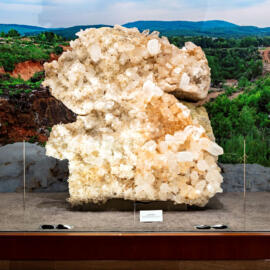
One of the most famous quartz specimens is the “Berns Quartz,” named after the donors that donated it to the Smithsonian’s National Museum of Natural History. It is an 8,000 pound (yes you read that correctly) slab of natural clear quartz and is one of the largest clusters ever found.
Herkimer diamonds are a famous type of quartz not for their rarity, but for their ability to pass for diamonds to the untrained eye. Of course, they are actually not diamonds at all but double-terminated quartz crystals found in Herkimer County in New York. They are known for their exceptional clarity and often exhibit a naturally faceted appearance.
They were discovered in the 1800’s while workers were mining in the Mohawk River Valley. They get the “diamond” part of their name because they are typically very high clarity with sharp facets that somewhat resemble the facets of a diamond. That said, they aren’t worth anything close to what a comparable natural diamond would be. So, the next time you see “diamonds” for sale online for a few dollars, make sure that the word “Herkimer” isn’t in the description.
The Malaga citrine, named after the city in Spain where it was once held, is the largest faceted citrine gemstone. The stone was found in 1990, and remained uncut until 2009 due to the the difficulty of faceting such a large stone. Finished, this flawless gem weighs 20,200 carats (just under 9 pounds) and has dimensions of 200mm x 150mm. In 2012 the stone disappeared from the public eye due to a legal dispute and has yet to resurface.
Mythology and Lore of Quartz
Quartz gems are important to a wide range of cultures, eras, and peoples. They are heralded in the Bible, Ancient Egypt, China, India, and many other civilizations. History is full of people who took power and comfort from one or another variety of quartz. So many of the quartz varieties listed above have their own history, mythology, and traditions stretching band millennia making it impossible to summarize them all there. Instead, we’ll look at a small handful of quartz species to share a snippet of the colorful tapestry that has been woven around this amazing mineral.
Rose Quartz is believed to be essential to fertility and is known as the stone of unconditional love. It is also believed to expel anger.
Agate is believed to embody attributes of resilience and bravery, amplifying cognitive faculties while promoting mental clarity and emotional stability. Agates are also believed to sharpen analytical skills, helping navigate challenges with precision and insight.
Bloodstone is believed to bring courage and wisdom. There is also a Christian connection with bloodstone where it is used to represent the sacrifice and bravery of Christ through his crucifixion.
History of Quartz
Because quartz and its varieties are so common and so diverse, we again are forced to pick and choose a small selection of stories.
There isn’t a specific date showing when quartz was found and this is probably because even the earliest humans would have had access to it. That being said there is documentation proving that Ancient Egyptians would wear various kinds of quartz (typically agate) around their necks to heal and protect against stiff necks. As early as 300 BC banded agate was found in Sicily, and the ancient Romans set up lapidary (stone cutting) facilities to process these stones and turn them into something beautiful. To this day agates and other varieties of quartz have been staples of the jewelry industry.
Quartz’s triboluminescent properties have been known for quite some time. The first scientific discovery of this effect was actually from sugar crystals in 1620, but it has been known by indigenous tribes for at least that long. The most famous example is the Uncompahgre Ute tribe in Colorado who would fill translucent rawhide rattles with quartz and shake them during ceremonies.
Quartz, whether it is common or exotic, intricate or simple, is an incredible gem that is worthy of the attention and praise it has received throughout history. We hope you have enjoyed our short journey through the wonderfully diverse world of quartz.
And remember, if you are looking for a special piece to add to your collection, our gemologists would love to help. Reach out to us anytime.
